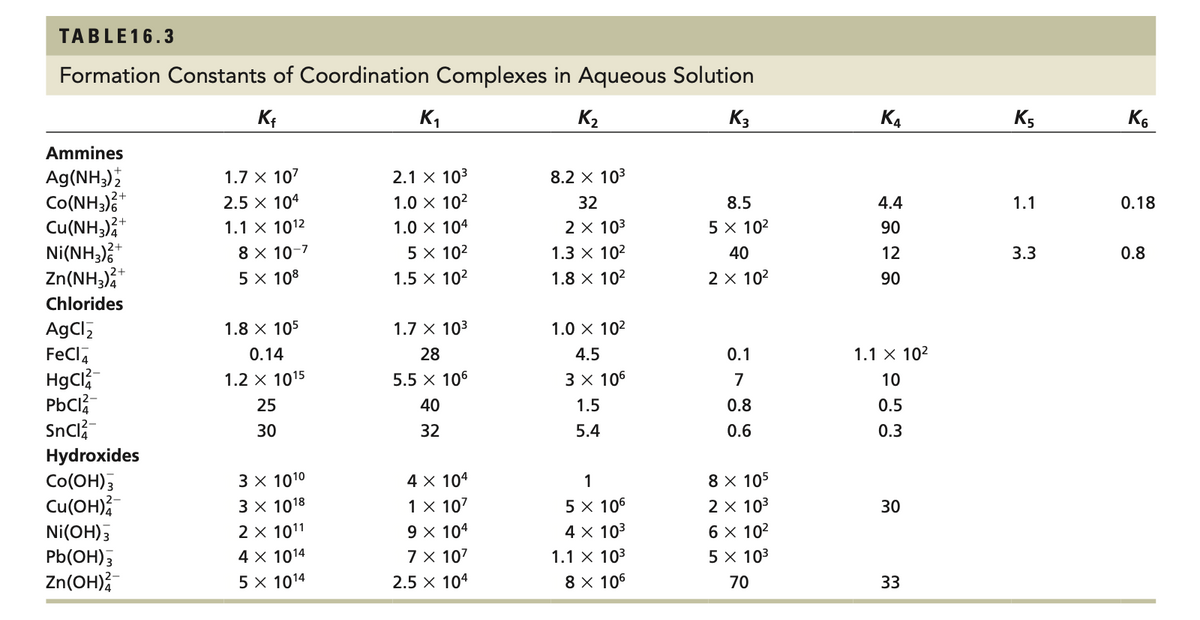*76. Using data from Table 16.3, calculate the concentrations of Hg²+(aq), HgCl*(aq), and HgCl2(aq) that result when 1.00 L of a 0.100 M Hg(NO3)2 solution is mixed with an equal volume of a 0.100 M HgCl, solution. (Hint: Use the analogy with amphoteric equilibria discussed in Sec- tion 10.8.)
*76. Using data from Table 16.3, calculate the concentrations of Hg²+(aq), HgCl*(aq), and HgCl2(aq) that result when 1.00 L of a 0.100 M Hg(NO3)2 solution is mixed with an equal volume of a 0.100 M HgCl, solution. (Hint: Use the analogy with amphoteric equilibria discussed in Sec- tion 10.8.)
Principles of Modern Chemistry
8th Edition
ISBN:9781305079113
Author:David W. Oxtoby, H. Pat Gillis, Laurie J. Butler
Publisher:David W. Oxtoby, H. Pat Gillis, Laurie J. Butler
Chapter16: Solubility And Precipitation Equilibria
Section: Chapter Questions
Problem 76AP
Related questions
Question
100%

Transcribed Image Text:TABLE16.3
Formation Constants of Coordination Complexes in Aqueous Solution
K,
K2
K3
K4
K5
K6
Ammines
Ag(NH;);
Co(NH;)*
Cu(NH,);
Ni(NH;)
Zn(NH,),*
1.7 x 107
2.1 X 103
8.2 x 103
2.5 x 104
1.0 X 102
32
8.5
4.4
1.1
0.18
1.1 X 1012
1.0 X 104
2 x 103
5 x 102
90
2+
8 x 10-7
5 X 108
5 x 102
1.3 x 102
40
12
3.3
0.8
12+
1.5 x 102
1.8 x 102
2 x 102
90
Chlorides
1.7 x 103
AgCl,
FeCl,
HgCl
PbCl?
SnCl?
1.8 X 105
1.0 X 102
0.14
28
4.5
0.1
1.1 X 102
1.2 x 1015
5.5 x 106
3 x 106
7
10
25
40
1.5
0.8
0.5
30
32
5.4
0.6
0.3
Hydroxides
зх 1010
3 x 1018
2 x 1011
4 × 1014
5 x 1014
8 x 105
4 X 104
1 x 107
9 x 104
7 X 107
Co(OH);
Cu(OH);
1
5 x 106
4 x 103
2 x 103
6 x 102
5 x 103
30
Ni(OH)3
Pb(OH);
Zn(OH)?
1.1 X 103
2.5 X 104
8 X 106
70
33

Transcribed Image Text:*76. Using data from Table 16.3, calculate the concentrations
of Hg²*(aq), HgCl*(aq), and HgCl2(aq) that result when
1.00 L of a 0.100 M Hg(NO3)2 solution is mixed with an
equal volume of a 0.100 M HgCl, solution. (Hint: Use
the analogy with amphoteric equilibria discussed in Sec-
tion 10.8.)
Expert Solution
This question has been solved!
Explore an expertly crafted, step-by-step solution for a thorough understanding of key concepts.
Step by step
Solved in 2 steps with 1 images

Knowledge Booster
Learn more about
Need a deep-dive on the concept behind this application? Look no further. Learn more about this topic, chemistry and related others by exploring similar questions and additional content below.Recommended textbooks for you

Principles of Modern Chemistry
Chemistry
ISBN:
9781305079113
Author:
David W. Oxtoby, H. Pat Gillis, Laurie J. Butler
Publisher:
Cengage Learning


Chemistry
Chemistry
ISBN:
9781305957404
Author:
Steven S. Zumdahl, Susan A. Zumdahl, Donald J. DeCoste
Publisher:
Cengage Learning

Principles of Modern Chemistry
Chemistry
ISBN:
9781305079113
Author:
David W. Oxtoby, H. Pat Gillis, Laurie J. Butler
Publisher:
Cengage Learning


Chemistry
Chemistry
ISBN:
9781305957404
Author:
Steven S. Zumdahl, Susan A. Zumdahl, Donald J. DeCoste
Publisher:
Cengage Learning

Chemistry: An Atoms First Approach
Chemistry
ISBN:
9781305079243
Author:
Steven S. Zumdahl, Susan A. Zumdahl
Publisher:
Cengage Learning

Chemistry: Matter and Change
Chemistry
ISBN:
9780078746376
Author:
Dinah Zike, Laurel Dingrando, Nicholas Hainen, Cheryl Wistrom
Publisher:
Glencoe/McGraw-Hill School Pub Co
